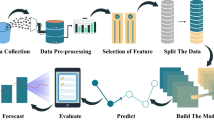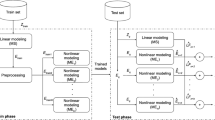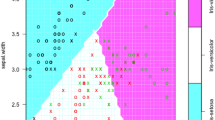Abstract
This work presents a novel and promising approach to the clinical management of acute stroke. Using machine learning techniques, our research has succeeded in developing accurate diagnosis and prediction real-time models from hemodynamic data. These models are able to diagnose stroke subtype with 30 min of monitoring, to predict the exitus during the first 3 h of monitoring, and to predict the stroke recurrence in just 15 min of monitoring. Patients with difficult access to a CT scan and all patients that arrive at the stroke unit of a specialized hospital will benefit from these positive results. The results obtained from the real-time developed models are the following: stroke diagnosis around 98% precision (97.8% sensitivity, 99.5% specificity), exitus prediction with 99.8% precision (99.8% Sens., 99.9% Spec.), and 98% precision predicting stroke recurrence (98% Sens., 99% Spec.).

Graphical abstract depicting the complete process since a patient is monitored until the data collected is used to generate models





Similar content being viewed by others
References
Stevens E, McKevitt C, Emmett E, Wolfe C, Wang Y (2017) El impacto del ictus en Europa. King’s College London, London
Oh SL, Hagiwara Y, Raghavendra U, Yuvaraj R, Arunkumar N, Murugappan M, Acharya UR (2018) A deep learning approach for Parkinson’s disease diagnosis from EEG signals. Neural Comput Applic, pp 1–7
Groselj C, Kukar M, Fettich J, Kononenko I (1997) Machine learning improves the accuracy of coronary artery disease diagnostic methods. In: Computers in cardiology 1997. IEEE, pp 57–60
Khosla A, Cao Y, Lin CC-Y, Chiu HK, Hu J, Lee H (2010) An integrated machine learning approach to stroke prediction. In: Proceedings of the 16th ACM SIGKDD International Conference on Knowledge Discovery and Data Mining. ACM, pp 183–192
Letham B, Rudin C, McCormick TH, Madigan D (2013) An interpretable stroke prediction model using rules and Bayesian analysis. In: Workshops at the Twenty-Seventh AAAI Conference on Artificial Intelligence
Zhang H, Zhang L-Q (2005) ECG analysis based on PCA and support vector machines. In: 2005 International Conference on Neural Networks and Brain, vol 2. IEEE, pp 743–747
Ozcan NO, Gurgen F (2010) Fuzzy support vector machines for ECG arrhythmia detection. In: 2010 20th International Conference on Pattern Recognition. IEEE, pp 2973–2976
Garg R, Oh E, Naidech A, Kording K, Prabhakaran S (2019) Automating ischemic stroke subtype classification using machine learning and natural language processing. J Stroke Cerebrovasc Dis 28 (7):2045–2051
Aviv R, Shelef I, Malam S, Chakraborty S, Sahlas D, Tomlinson G, Symons S, Fox A (2007) Early stroke detection and extent: impact of experience and the role of computed tomography angiography source images. Clin Radiol 62(5):447–452
Lee E-J, Kim Y-H, Kim N, Kang D-W (2017) Deep into the brain: artificial intelligence in stroke imaging. J Stroke 19(3):277
Bentley P, Ganesalingam J, Jones ALC, Mahady K, Epton S, Rinne P, Sharma P, Halse O, Mehta A, Rueckert D (2014) Prediction of stroke thrombolysis outcome using CT brain machine learning. NeuroImage: Clin 4:635–640
Cheon S, Kim J, Lim J (2019) The use of deep learning to predict stroke patient mortality. Int J Environ Res Public Health 16(11):1876
Asadi H, Dowling R, Yan B, Mitchell P (2014) Machine learning for outcome prediction of acute ischemic stroke post intra-arterial therapy. PloS one 9(2):e88225
Zhang Q, Xie Y, Ye P, Pang C (2013) Acute ischemic stroke prediction from physiological time series patterns. Austral Med J 6(5):280–286
Vrtková A, Procházka V (2019) Comparing the performance of regression models, random forests and neural networks for stroke patients’ outcome prediction. In: 2019 International Conference on Information and Digital Technologies (IDT). IEEE, pp 543–550
Shokoohi-Yekta M, Hu B, Jin H, Wang J, Keogh E (2017) Generalizing DWT to the multi-dimensional case requires an adaptive approach. Data Mining Knowl Discov 31(1):1–31
García-Terriza L, Risco-Martín JL, Ayala JL, Roselló GR, Camarasaltas JM (2019) Comparison of different machine learning approaches to model stroke subtype classification and risk prediction. In: Proceedings of the Modeling and Simulation in Medicine Symposium, Society for Computer Simulation International, p 6
Zitzler E (1999) Evolutionary algorithms for multiobjective optimization: methods and applications. Ph.D. thesis, Swiss Federal Institute of Technology (ETH)
Hatib F, Jian Z, Buddi S, Lee C, Settels J, Sibert K, Rinehart J, Cannesson M (2018) Machine-learning algorithm to predict hypotension based on high-fidelity arterial pressure waveform analysis. Anesthesiol J Amer Soc Anesthesiol 129(4):663– 674
Kendale S, Kulkarni P, Rosenberg AD, Wang J (2018) Supervised machine-learning predictive analytics for prediction of postinduction hypotension. Anesthesiol J Amer Soc Anesthesiol 129(4):675–688
Convertino VA, Moulton SL, Grudic GZ, Rickards CA, Hinojosa-Laborde C, Gerhardt RT, Blackbourne LH, Ryan KL (2011) Use of advanced machine-learning techniques for noninvasive monitoring of hemorrhage. J Trauma Acute Care Surg 71(1):S25–S32
Shoemaker WC, Wo CC, Lu K, Chien L-C, Bayard DS, Belzberg H, Demetriades D, Jelliffe RW (2006) Outcome prediction by a mathematical model based on noninvasive hemodynamic monitoring. J Trauma Acute Care Surg 60(1):82–90
Prasad V, Guerrisi M, Dauri M, Coniglione F, Tisone G, De Carolis E, Cillis A, Canichella A, Toschi N, Heldt T (2017) Prediction of postoperative outcomes using intraoperative hemodynamic monitoring data. Scient Rep 7(1):1–11
Lee H, Lee E-J, Ham S, Lee H-B, Lee JS, Kwon S, Kim J, Kim N, Kang D-W Machine learning approach to identify stroke within 4.5 hours, Stroke 51. https://doi.org/10.1161/STROKEAHA.119.027611
Funding
We acknowledge support from the Spanish Ministry of Science and Innovation under project PID2019-110866RB-I00.
Author information
Authors and Affiliations
Corresponding author
Additional information
Publisher’s note
Springer Nature remains neutral with regard to jurisdictional claims in published maps and institutional affiliations.
Rights and permissions
About this article
Cite this article
García-Terriza, L., Risco-Martín, J.L., Roselló, G.R. et al. Predictive and diagnosis models of stroke from hemodynamic signal monitoring. Med Biol Eng Comput 59, 1325–1337 (2021). https://doi.org/10.1007/s11517-021-02354-6
Received:
Accepted:
Published:
Issue Date:
DOI: https://doi.org/10.1007/s11517-021-02354-6




